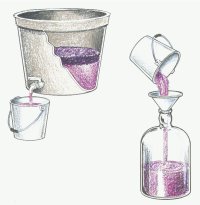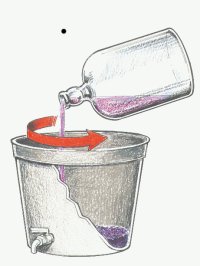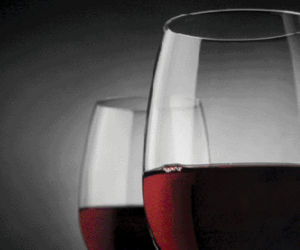
As an enophile, I enjoy almost every type and style of wine. However, my true love is — and always has been — big, bold, oak-aged reds, the type built for the long run. My favorites include rich, peppery California Cabernet Sauvignon, tannin-rich Piedmontese (Italian) Nebbiolo or chocolate-scented Australian Shiraz (known as Syrah in North America).
As a home winemaker, my goal has always been to replicate such world-class wines, which could be cellared for many years. I macerate my reds 14–21 days, with frequent pump-over or punching of the cap for maximum phenolic extraction, and age them 6–12 months in American and French oak barrels. I typically bottle three years after the vintage and drink them over the next five to seven years.

Maceration is the process of soaking or fermenting red wine with its grape solids. The cap is the layer of grape solids that floats to the top of the wine during fermentation. Pump-over and cap punching are cap management techniques used in red winemaking to extract phenolic compounds — such as color pigments, tannins and flavors — from the grape solids, and to keep the grape solids soaked to prevent spoilage.
The drawback of such wines is that they can be overly astringent in their youth, particularly those that have spent some time in oak barrels. They are not approachable before a few years of aging, which is required to tame the tannins. As my palate evolved, I wanted the same style of wine, but one that would be more approachable when young and exhibit a fruitier nose with a rounder, less astringent mouthfeel. The solution? Delestage fermentation.
Delestage is a fermentation and maceration technique used in red winemaking from grapes that gently extracts phenolic compounds by oxygenating the juice to produce a softer, less astringent wine exhibiting more fruit character. (The word “delestage” is from the French “délestage.” It means “lightening,” in reference to the separation of juice and grape solids. It is pronounced day-leh-staj.) In fact, Dr. Bruce Zoecklein’s research at Virginia Tech has demonstrated that delestage-fermented wines have a lower concentration of tannins and a higher concentration of esters, key compounds that contribute fruitiness (Leahy, 2000). Given the lower concentration of tannins, delestage-fermented wines will generally not age as long as traditionally fermented, tannin-rich, oak-aged wines, but this is strictly a matter of style and preference.
Although many wineries use this technique, particularly in making Pinot Noir, delestage is practically unknown to home winemakers because its practice and benefits are not often covered in the home winemaking literature. And being labor intensive, delestage is a process best suited for commercial wineries outfitted with the appropriate equipment. However, a simple process adaptation to home winemaking can significantly reduce the effort and still provide the benefits of delestage.
What is delestage?
Delestage is a two-step “rack-and-return” process in which fermenting red wine juice is separated from the grape solids by racking and then returned to the fermenting vat to re-soak the solids. This step is then repeated daily.
Racking the fermenting juice oxygenates, or aerates, the wine and softens the astringent tannins through oxidation. It also stabilizes the wine’s color. Racking during maceration and fermentation is the underlying difference from traditional maceration-fermentation, in which the juice ferments under a layer of carbon dioxide (CO2) gas and is seldom aerated until racked at the end of fermentation. Pump-over (the re-circulation of wine from the bottom of the fermentation vat to the top to soak the grape solids) is sometimes used to aerate the wine but does not provide the same effects as delestage because the wine is never separated entirely from the grape solids.
During delestage racking, the cap slowly falls to the bottom of the vat while the wine is allowed to drain completely under the weight of the grape solids. Once the wine is completely racked, a portion of the grape seeds is removed to avoid imparting the harsh tannins in seeds to the wine.
Following racking, the grape solids are allowed to settle separately from the fermenting wine for one to two hours or more depending on the size of the fermenting vat. The fermenting wine is returned to the vat over the cap using a gentle, high-volume pump to completely soak the grape solids for maximum color and flavor extraction while minimizing extraction of harsh phenols.
This process is repeated daily until the end of fermentation. As fermentation progresses, more seeds are released from the grapes, a portion of which can be removed during each racking operation.
An advantage of delestage is that the rack-and-return operation favors juice extraction from grape solids and increases free-run yield, and therefore requires less pressing of the solids at the end of fermentation. Macerating enzymes can also be used to help break down cell walls of red grapes for a more gentle extraction of phenolic compounds, thereby increasing the effects of delestage.
For the home winemaker
Delestage can be made to be a relatively easy process for home winemakers while still achieving the same benefits.
The fermentation vat should be equipped with a faucet at the bottom. The vat should be positioned in a slanted position to allow fermenting juice to drain freely from the faucet during the racking operation while allowing the removal of as many seeds as possible. You will not be able to remove all the seeds; expect to remove up to one-third by the end of fermentation. Use a standard 5-gallon (19-L) pail for receiving the wine being racked along with a sieve to separate seeds and other grape solids from the wine.
Have sufficient small demijohns or carboys for fermenting wine during the racking and settling period. Use small 5- or 6-gallon (19 or 23-L) glass containers — or better yet, plastic carboys — as you will need to lift these up above waist level during the “return” operation. Get an extra pair of hands to help you and avoid injuring your back. Commercial wineries use gentle, high-volume pumps to displace large volumes of wine during delestage. The much smaller volume in home winemaking does not warrant the cost of a pump. In addition, special paraphernalia or fermentation tanks with special screens are required to separate the seeds from the juice. Home winemaking pumps are not designed for this type of juice handling.
When planning capacity and carboys required, figure a total yield of 7 to 8 gallons of wine per 100 pounds of grapes (6–7 liters per 10 kg of grapes) on average. The yield will progressively increase following each daily racking operation. The maximum total yield depends mainly on the grape variety and fruit quality, as well as on the use of enzymes.
To perform delestage, let fermentation start and allow it to proceed until the cap forms on top of the fermenting juice. This may take up to two or three days depending on the temperature of the fermentation area. Adjust the temperature to avoid having the fermenting wine exceed the mid- 80s (30° C), which could otherwise cause fermentation problems. And be sure to protect the must with a heavy tarpaulin to keep fruit flies out and to protect it from spoilage bacteria during fermentation.
Once the cap has formed, place the sieve and pail under the faucet, then open the faucet slowly and completely until the pail is filled. Close the faucet, transfer the wine to a carboy, and remove whatever seeds have been collected in the sieve. Repeat this until all the wine is completely drained.
During racking, the cap will slowly and gradually fall to the bottom of the vat. While the cap rests at the bottom, more wine will drain under the weight of the grape solids. Leave the faucet open with the pail under it until no more wine drains. Depending on your grape volume, this may take up to one hour or two, possibly more. Transfer this wine to a carboy, and then ensure that all containers are properly topped up and protected with fermentation airlocks.
At the end of the racking period (i.e. when no more wine drains), wine in the carboys must be returned to the fermenting vat. This is the part of delestage where an extra pair of hands will be required. Alternatively, you can use a high-volume home winemaking pump in this operation because the wine is free of large solids and does not require any special handling. The idea is to douse the grape solids quickly and thoroughly so that the wine rises faster than the solids while pouring or pumping. This maximizes interaction between the cap and the wine, and optimizes the effects of delestage. If pouring from a carboy, have someone help you to lift and hold the heavy container. If you make more than 50 gallons (200 L) per year, consider investing in a good pump if you intend to ferment using delestage.
Repeat the rack-and-return procedure each day or every other day. Delestage should be used in conjunction with cap punching, i.e., continue breaking and submerging the cap as usual, two or three times daily, to maximize color extraction and protect the wine from spoilage bacteria.
Maximizing the benefits
The benefits of delestage — higher concentration of fruity flavors, softer tannins and more stable color — can be optimized through the use of selected fermentation yeasts and macerating enzymes.
Use a low-foam yeast specifically recommended for reds where supple mouthfeel and concentrated fruit aromas are desired. Foamy yeasts tend to inhibit the benefits of delestage. Brad McCarthy, winemaking consultant at White Hall Vineyards in Charlottesville, Virginia, recommends and uses Lallemand’s low-foaming Lalvin D254 yeast in crafting their reds (Leahy, 2000). D254 yeast is particularly recommended for Syrah-based wines and adds a touch of spiciness. If you cannot find this yeast, suitable substitutes include Lallemand’s Lalvin RC212, highly recommended for Pinot Noir-based wines, Red Star’s Pasteur Red, highly recommended for Cabernet Sauvignon-based wines, Wyeast’s Pasteur Red or White Labs’ Cabernet Red Wine (WLP760).
Macerating enzymes can improve color stability and enhance mouthfeel for smoother reds through a more gentle extraction of phenolic compounds. Macerating enzymes are added to the must before the start of fermentation; they do their work during the maceration phase in red winemaking. Two examples of macerating enzyme products on the market recommended for wines to be fermented by delestage are Lallemand’s Lallzyme EX or Scott Laboratories’ Scottzyme Color Pro.
Since these products are mainly used in commercial winemaking, they are mainly available in sizes larger than most home winemaker’s needs. Lallemand’s Lallzyme EX is now available in a small format good for 5-gallon batches. Alternatively, you can buy larger formats and share with fellow home winemakers. A package can be used for two vintages if it is stored in a well-sealed container in a refrigerator. Be sure to follow the manufacturer’s instructions and recommended rate of addition.
Reference
Leahy, Richard. “Délestage Fermentation: From Bitter to Better Reds.” Vineyard & Winery Management. Sept./Oct. 2000, Vol. 26, No. 5.







